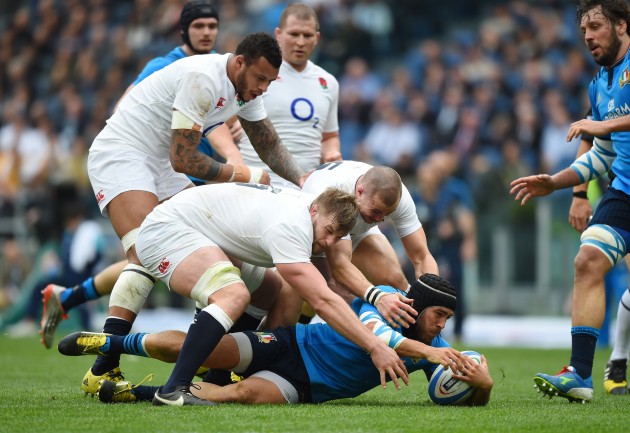Two games in to the Six Nations, a pattern is starting to appear which is based around defence and the emerging influence of former Saracens defensive coach Paul Gustard
After the first two rounds of the 2016 Six Nations, the essential character of England under Eddie Jones is beginning to emerge. While some areas of performance have remained at a roughly similar level to Stuart Lancaster’s side in last year’s tournament, and others have deteriorated (lineout and attack), the one department where England have clearly improved is in defence, and most especially in their ability to create turnovers. This is the influence of Saracens, and in particular it is the influence of Paul Gustard.
At this stage last year, England had already conceded four tries, this season their opponents have yet to cross the whitewash. More significantly, four of the seven tries they have scored have come directly from defensive pressure – the other three have occurred from attacking situations close to the opposition goal-line.

Passing it on: Gustard talks to Owen Farrell and George Ford
Against Italy last weekend, England created 12 turnovers, winning more than 11% of situations where Italy were in possession. There were two major areas where defensive wins occurred:
- FOUR kick-chase turnovers, leading directly to two tries, one England five metre scrum, and a fourth clear scoring opportunity (12 points)
- FIVE turnovers from 1st receiver defence, leading to one goaled penalty in the 15th minute and another try in the 71st minute (8 points).
…and the timing of the wins was also interesting:
- Number of wins (minutes 1-50) – FIVE (one try)
- Number of wins (minutes 51-80) – SEVEN (two tries)
When England converted their second turnover try through Jonathan Joseph’s interception, they moved out to more than two scores beyond Italy at 9-18. That try radically changed the mood of what had been an evenly-matched contest. Italy were forced to chase the game from their own half (their weakest suit) against England’s aggressive defence (their opponent’s strong suit) and it was this new dynamic which produced the lopsided, runaway final score-line.
Let’s take a look at some examples how England pressurized Italy, particularly off their kicking game:
England’s results are based squarely on enthusiasm and desire in the kick chase. In the examples at 23:43 and 43:50, the first two chasers (No 12 Owen Farrell and No 13 Joseph in the first example; No 6 Chris Robshaw and No 14 Anthony Watson in the second) make sure they arrive before the first Italian support player. This in turn means that they can create forward momentum and a platform for the third and fourth players arriving (No 15 Brown and No 7 James Haskell; No 2 Dylan Hartley and Farrell respectively) to flood the tackle area and win turnover.
The same enthusiasm and desire are present in the kick chase that results in Joseph’s key third quarter try. When the Italy left wing no.11 Mattia Bellini receives the quick lineout throw from no.10 Carlo Canna and decides to take half a dozen steps outside the safety of his 22 metre zone, his fate is already sealed. At 52:18, there are no less than 10 England chasers in the frame and only two Italy support players behind Bellini. Making passes in this situation is a sure recipe for disaster!

The fumble: Kruis hits Castro
The final example at 70:00 emphasizes the Saracens foundation of this style of play. Sarries’ hooker Jamie George is the first to break up Italy’s grip on possession, getting good penetration at the first Azzurri ruck. Then George Kruis smashes the Italy 1st receiver at 70:14, forcing the ‘winning’ fumble from Martin Castrogiovanni.
The coaching mind behind this activity is of course Gustard. The Saracens style has taken the European Champions Cup by storm on the group stages – the question is, can it do the same in the remainder of the Six Nations against higher quality teams? England have shown that they will kick from anywhere in the area between the two 40 metre lines (77 kicks in two games so far!) and chase hard to generate turnovers and easy scoring opportunities off them in the opposition last third of the field. They have also shown that they will attack the opposition 1st receiver hard with the same aim in view. England’s next opponent Ireland prides itself on control of the breakdown and they will defend far more resolutely in the backfield, with the Kearney brothers in situ. All the pointers are towards a much tighter and more intense contest than Eddie Jones’s England has yet experienced.





